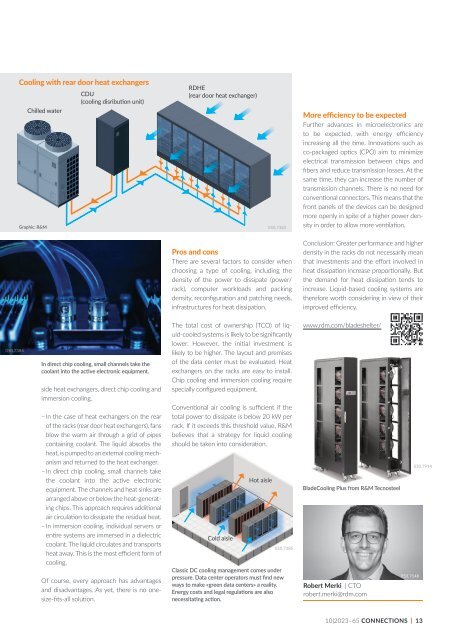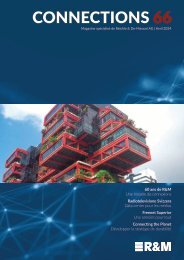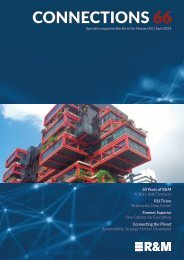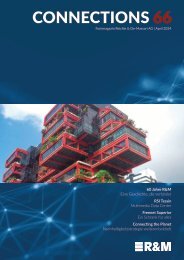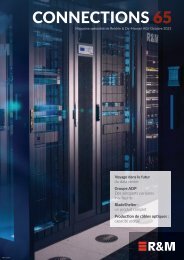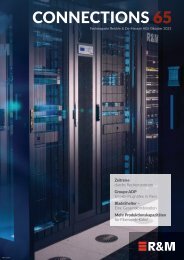CONNECTIONS_65-e
Specialist magazine CONNECTIONS no. 65
Specialist magazine CONNECTIONS no. 65
Create successful ePaper yourself
Turn your PDF publications into a flip-book with our unique Google optimized e-Paper software.
Cooling with rear door heat exchangers<br />
Chilled water<br />
Graphic: R&M<br />
CDU<br />
(cooling disribution unit)<br />
RDHE<br />
(rear door heat exchanger)<br />
050.7382<br />
More efficiency to be expected<br />
Further advances in microelectronics are<br />
to be expected, with energy efficiency<br />
increasing all the time. Innovations such as<br />
co-packaged optics (CPO) aim to minimize<br />
electrical transmission between chips and<br />
fibers and reduce transmission losses. At the<br />
same time, they can increase the number of<br />
transmission channels. There is no need for<br />
conventional connectors. This means that the<br />
front panels of the devices can be designed<br />
more openly in spite of a higher power density<br />
in order to allow more ventilation.<br />
Pros and cons<br />
There are several factors to consider when<br />
choosing a type of cooling, including the<br />
density of the power to dissipate (power/<br />
rack), computer workloads and packing<br />
density, reconfiguration and patching needs,<br />
infrastructures for heat dissipation.<br />
Conclusion: Greater performance and higher<br />
density in the racks do not necessarily mean<br />
that investments and the effort involved in<br />
heat dissipation increase proportionally. But<br />
the demand for heat dissipation tends to<br />
increase. Liquid-based cooling systems are<br />
therefore worth considering in view of their<br />
improved efficiency.<br />
050.7384<br />
In direct chip cooling, small channels take the<br />
coolant into the active electronic equipment.<br />
side heat exchangers, direct chip cooling and<br />
immersion cooling.<br />
– In the case of heat exchangers on the rear<br />
of the racks (rear door heat exchangers), fans<br />
blow the warm air through a grid of pipes<br />
containing coolant. The liquid absorbs the<br />
heat, is pumped to an external cooling mechanism<br />
and returned to the heat exchanger.<br />
– In direct chip cooling, small channels take<br />
the coolant into the active electronic<br />
equipment. The channels and heat sinks are<br />
arranged above or below the heat-generating<br />
chips. This approach requires additional<br />
air circulation to dissipate the residual heat.<br />
– In immersion cooling, individual servers or<br />
entire systems are immersed in a dielectric<br />
coolant. The liquid circulates and transports<br />
heat away. This is the most efficient form of<br />
cooling.<br />
Of course, every approach has advantages<br />
and disadvantages. As yet, there is no onesize-fits-all<br />
solution.<br />
The total cost of ownership (TCO) of liquid-cooled<br />
systems is likely to be significantly<br />
lower. However, the initial investment is<br />
likely to be higher. The layout and premises<br />
of the data center must be evaluated. Heat<br />
exchangers on the racks are easy to install.<br />
Chip cooling and immersion cooling require<br />
specially configured equipment.<br />
Conventional air cooling is sufficient if the<br />
total power to dissipate is below 20 kW per<br />
rack. If it exceeds this threshold value, R&M<br />
believes that a strategy for liquid cooling<br />
should be taken into consideration.<br />
Cold aisle<br />
Hot aisle<br />
050.7385<br />
Classic DC cooling management comes under<br />
pressure. Data center operators must find new<br />
ways to make «green data centers» a reality.<br />
Energy costs and legal regulations are also<br />
necessitating action.<br />
www.rdm.com/bladeshelter/<br />
BladeCooling Plus from R&M Tecnosteel<br />
Robert Merki | CTO<br />
robert.merki@rdm.com<br />
050.7148<br />
030.7914<br />
10|2023–<strong>65</strong> <strong>CONNECTIONS</strong> | 13


